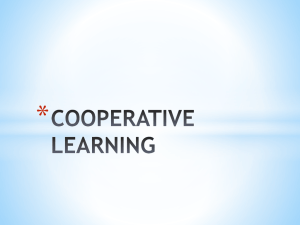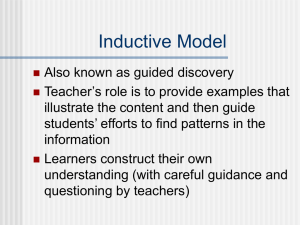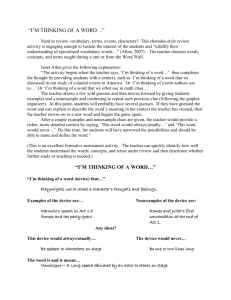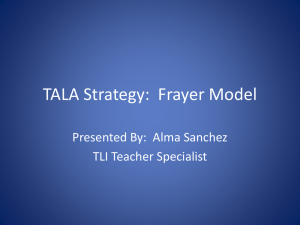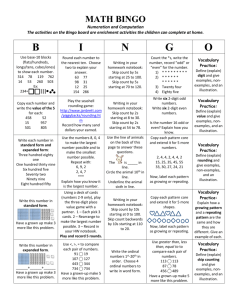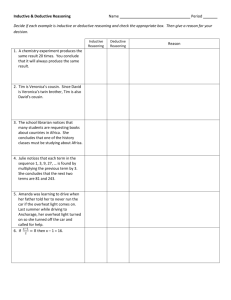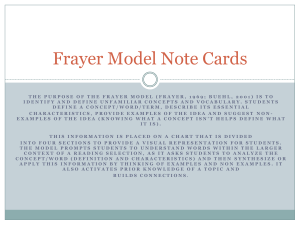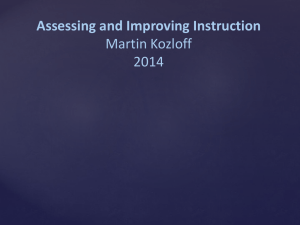How Does The Learning Mechanism Figure Out The General Idea
advertisement
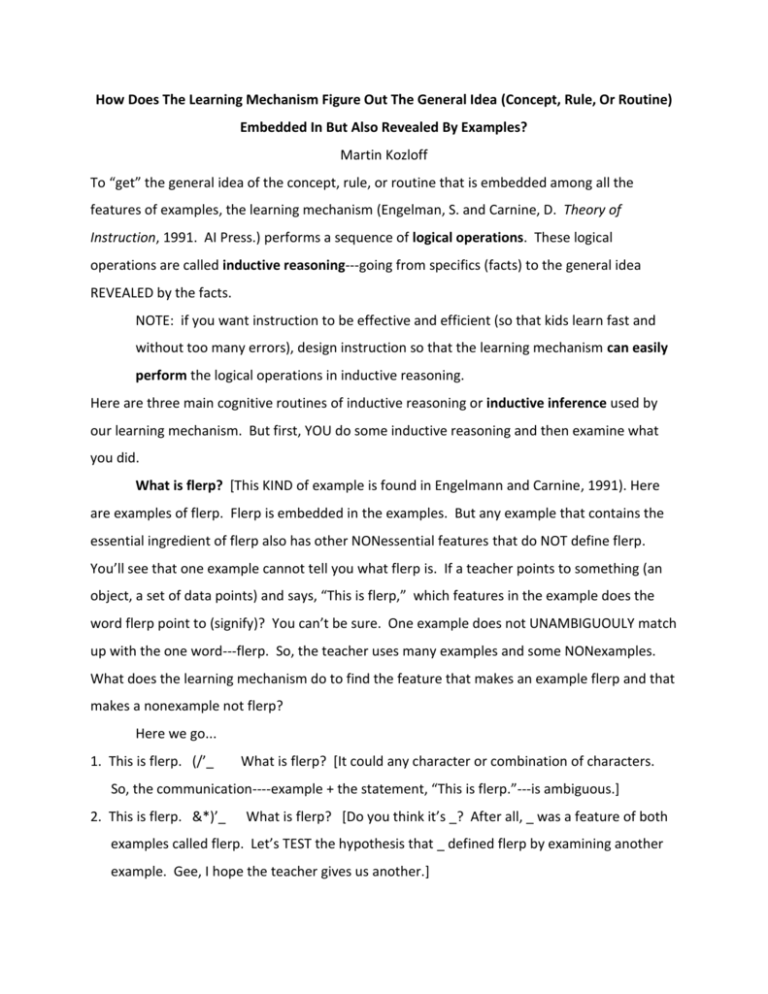
How Does The Learning Mechanism Figure Out The General Idea (Concept, Rule, Or Routine) Embedded In But Also Revealed By Examples? Martin Kozloff To “get” the general idea of the concept, rule, or routine that is embedded among all the features of examples, the learning mechanism (Engelman, S. and Carnine, D. Theory of Instruction, 1991. AI Press.) performs a sequence of logical operations. These logical operations are called inductive reasoning---going from specifics (facts) to the general idea REVEALED by the facts. NOTE: if you want instruction to be effective and efficient (so that kids learn fast and without too many errors), design instruction so that the learning mechanism can easily perform the logical operations in inductive reasoning. Here are three main cognitive routines of inductive reasoning or inductive inference used by our learning mechanism. But first, YOU do some inductive reasoning and then examine what you did. What is flerp? [This KIND of example is found in Engelmann and Carnine, 1991). Here are examples of flerp. Flerp is embedded in the examples. But any example that contains the essential ingredient of flerp also has other NONessential features that do NOT define flerp. You’ll see that one example cannot tell you what flerp is. If a teacher points to something (an object, a set of data points) and says, “This is flerp,” which features in the example does the word flerp point to (signify)? You can’t be sure. One example does not UNAMBIGUOULY match up with the one word---flerp. So, the teacher uses many examples and some NONexamples. What does the learning mechanism do to find the feature that makes an example flerp and that makes a nonexample not flerp? Here we go... 1. This is flerp. (/’_ What is flerp? [It could any character or combination of characters. So, the communication----example + the statement, “This is flerp.”---is ambiguous.] 2. This is flerp. &*)’_ What is flerp? [Do you think it’s _? After all, _ was a feature of both examples called flerp. Let’s TEST the hypothesis that _ defined flerp by examining another example. Gee, I hope the teacher gives us another.] 3. This is flerp. \*^#( What is flerp? [Do you still think it’s _? But how could it be? Examples 1 and 2 had _ and were called flerp, but example 3 does NOT have _, and it’s still called flerp. So, flerp can’t be _. Hmmm, anything ELSE shared by examples 1-3?] 4. This is NOT flerp. \’^# What is flerp? [Did you contrast 3 and 4? They are the same in every way except……? What did you find? What is flerp?] 5. This is NOT flerp. _&\* What is flerp? 6. This IS flerp. _&\*) What is flerp? [Does this example confirm your inference about what is flerp?] 7. This IS flerp. /’(^# What is flerp? What was the logical process by which you figured it out, or induced the generalization: Flerp is……..? Did you compare examples called flerp and find the one thing that was always there---the way in which they AGREED? “Whenever it’s called flerp, there is………” Did you compare examples of NOT flerp with examples of flerp to find the one feature that was not there in NOT flerp but was there in flerp? “Whenever it’s called NOT flerp, there is NOT….” Did you contrast juxtaposed (next to each other) examples of flerp and not flerp (3 and 4; 5 and 6), and identify the one thing that was different? “Flerp must be whatever is always there when it’s called flerp and what’s NOT there when it’s called NOT flerp. Therefore, flerp is…..” A curved line. That is how learning works. It’s all logic. So, teachers can yack yack and yack, but their kids will ONLY make the correct inference---GET how the problems are solved, how the words are sounded out, what the rule is that ius revealed by data---ONLY when the teacher presents examples that CLEARLY show the SHARED defining features and TREATS these examples the same way (e.g., names them, solves them), and when teachers show NONexamples that are LIKE the examples, but are MISSING the defining features, and the teacher treats these differently from the examples (e.g., gives them a different name, or does not solve them the same way). There are different routines of logical operations for comparing and contrasting examples and nonexamples, and then drawing a conclusion about what is connected to what, or what causes what. These routines of logical operations are called inductive reasoning. Here are three common forms of inductive reasoning when we ACQUIRE knowledge, or learn. If you want the whole story, see John Stuart Mill’s book, A system of logic, or Introduction to logic by Irving Copi. a. Method of agreement. Examples are different in nonessential features but AGREE in (all have) the essential features. If they are all “treated” the same way (named, solved), it must be because of the way in which they agree. Here… The four examples with features.… Reveal the concept, rule, or routine that is called or treated in fashion… 1. A B C D X 2. K A L O X 3. U T A B X 4. O F C A X What shared feature of the examples makes them concept, rule, or routine X? It must be the one way or feature that they all have---in agreement? A. How to Teach Using the Method of Agreement. (1) Show a range of examples that are different in nonessential ways but that clearly are the same in the one essential way. A red ball, a red triangle, a red cube, a red scarf. (2) Name the examples the same way. “This is red.” “This shows how demand decreases when price increases.” “This shows the routine for multiplying 2-digit numbers.” (3) Help students to compare and contrast the examples, and to identify the sameness---which IS the general idea (concept, rule, routine). Flerp examples 1, 2, 3, 6, 7 are the method of agreement. ****Your turn. Select and order examples and nonexamples for teaching the concept on. What will you say when you show each one? ****Your turn again. Select and order examples and nonexamples for teaching the concept bird. What will you say when you show each one? b. Method of difference. Examples and nonexamples are the SAME in nonessential features, but DIFFER in the essential feature. If the examples and nonexamples are treated (e.g., named, solved) differently (“This is red… This is not red.” “This is a constitutional republic….This is NOT a constitutional republic.” “This is how to multiply 2-digit numbers….. This is NOT how to multiply 2-digit numbers.”), then the difference between examples and nonexamples must be what makes the difference in what they are called or how they are solved. Here…. The juxtaposed examples and nonexamples Reveal the concept, rule, or routine that is called that have features… or treated in fashion…. ABCD X BCD Not X YPLA X YPL Not X Note: putting the example and nonexample next to each other (juxtaposition), makes the difference that makes the difference obvious. So, what feature of examples makes them concept, rule, or routine X. A. How to Teach Using the Method of difference. (1) Juxtapose examples and nonexamples that are the same in their nonessential features but differ (disagree) in having/not having the essential feature. (2) Help students to compare and contrast juxtaposed examples and nonexamples, and to identify the difference that makes the difference. (3) Help students to draw a conclusion. “So X must be defined by….?” Contrasting flerp examples 1, 2, 3, 6, 7 with nonFlerp examples 4 and 5 is the method of difference. Note, the procedure above for teaching flerp used BOTH the method of agreement (when it showed a string of examples---1, 2, 3), and it used the method of difference when it juxtaposed examples and nonexamples in 3 and 4, 5 and 6. ****Your turn. Use juxtaposed examples and nonexamples (method of difference) for teaching the concepts (1) on and (2) bird. c. Method of concomitant variation. If there are many instances (facts) in which (1) one thing changes (e.g., the demand for gold), but everything else (e.g., weather, price of housing) stays the same, and then (2) another thing changes in a regular way (e.g., price of gold), then it is reasonable to infer that the two things that change together are somehow connected in a functional (correlational) or causal relationship. This form of inductive reasoning is used especially in discovering rule relationships. Watch… Here are some facts. 1. When A is 3, B is 5, C is 11, and D is 10, we notice that Y (which was 18 soon changes to 23. 2. When A is 3, B is 5, C is 11, and D is 5, Y soon changes to 12. 3. When A is 3, B is 5, C is 11, and D is 20, Y soon changes to 34. 4. When A is 3, B is 5, C is 11, and D is 15, Y soon changes to 28. 5. When A is 3, B is 5, C is 11, and D is 50, Y soon changes to70. You can see that D varies in value. Soon after, Y varies in value. While A, B, and C stay the same. Logically A, B, and C can’t cause Y because Y changes even when A, B, and C don’t. So…If Y changes in a REGULAR way (e.g., increases or decreases) ONLY when D varies in a regular way, it is logical to infer that Y changes AS A FUNCTION OF changes in D? Since Y and D vary together---co-vary---it is logical to conclude (tentatively) that change in D is one part of the cause of change in Y. How to Teach Using the Method of Agreement. This method of arranging examples is best used with relationships that involve change. (1) Show examples that have many features that do not change (are constant), and one feature that does change first, followed by something else that changes. (2) Juxtapose the examples reveal clearly how the two features co-vary while the rest of the features are constant. (3) Help students come to the conclusion (infer) that the constant features can’t be causes of changes in Y. Logically, change in Y must result from change in D. **** Your turn. Select and arrange examples to show concomitant variation, to teach (1) the concept steeper, and (2) the rule, “When pressure of a gas increases in a closed vessel, the temperature of the gas increases.” Or, “Temperature of gas in a closed container varies directly with pressure.”
